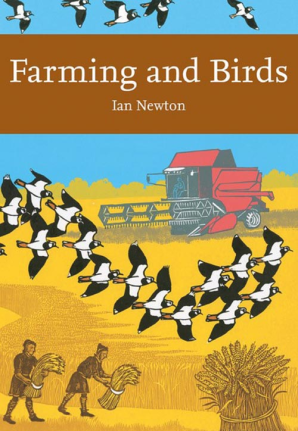
I sometimes wonder how many New Naturalists are read rather than collected as an investment – well this one should be read.
Ian Newton has never produced a duff book – his works are characterised by clarity and suffused by a deep knowledge of the biology of the subjects on which he writes. This one is no different but tackles a big and important subject with a huge scientific literature. Ian does the usual superb job of distilling the information into a structured and comprehensible volume – but it is still over 600 pages long.
I challenge anyone, however involved in the subject they might be, not to learn a lot from this book. It’s a masterful review, habitat by habitat and issue by issue.
Where the book is a little weak is in putting forward solutions so that things get better. And that might be because the future of public support for agriculture will involve biodiversity issues much wider than just birds, and economic, social and other environmental issues too.
There are a lot of photographs of birds in this book and not that many of farming. I’m not sure that I really needed photographs of Dunnocks or Pheasants but more well-chosen landscapes or images that illustrated farming practices would have been welcome. And the rather few graphs in this book all helped tell their stories well – it would have been good to have more of them (but I’m a fan of graphs).
This is a superb book of reference and source of information on one of the most sorry losses of wildlife in all of our lives. It says so much that modern farming has removed birds, insects and plants from our lives – not deliberately, but none the less efficiently for it being an unintended consequence. We could do so much better.
Farming and Birds by Ian Newton is published by William Collins.
Ian Newton is speaking at the Bird Fair in Lecture Theatre 1 on Friday, 1030-1050 on ‘Hedgerows’ and will be signing books at the WildSounds stand afterwards and then again, on the same title as this book at the Authors’ forum from 1315-1400 (Whoa! clashing with an event of which I am a part!).
Remarkable Birds by Mark Avery is published by Thames and Hudson – for reviews see here.
Inglorious: conflict in the uplands by Mark Avery is published by Bloomsbury – for reviews see here.
Behind the Binoculars: interviews with acclaimed birdwatchers by Mark Avery and Keith Betton is published by Pelagic – here’s a review and it’s now out in paperback.
[registration_form]

Sounds like a great reference. Does he look at UK farm practices in relation to wildlife/bird declines, or global ones? In ‘The Moth Snowstorm’ Michael McCarthy also looks into several of the key developments related to agriculture that have severely impacted bird and wildflower/native wildlife populations. He writes that after the Second World War two major changes happened in English agriculture: new technology (machines, chemicals and techniques), and also, with a larger impact the process called ‘intensification’; encouraging farmers to grow as much as possible, in marginal places. Hedges and orchards, some centuries old, were bulldozed
He also emphasizes the major negative impacts of the change from spring-sown crops to fall-sown, regarding bird nesting (nests were crushed by harvesting machines in July), whereas previously grown nesting birds had time to raise their young before a summer harvest and fall planting.
Also when the switch was made from hay to perennial ryegrass (as known as ‘green concrete’ the ryegrass, heavily fertilized, outcompeted all the wildflowers, so invertebrates that fed and bred on them were seriously impacted. This was called ‘improvement’. ” It is thought about 97% of them have gone now.” The ryegrass grew very quickly so was cut at the beginning of June, then six weeks later, and sometimes a third or even fourth cut before summer’s end.
These practices need to be examined on a mass scale to accommodate wildlife if we are not to lose it altogether. Perhaps subsidies to set land corridors aside for native meadows and grazing areas or other ways to ensure habitat is available year-round.